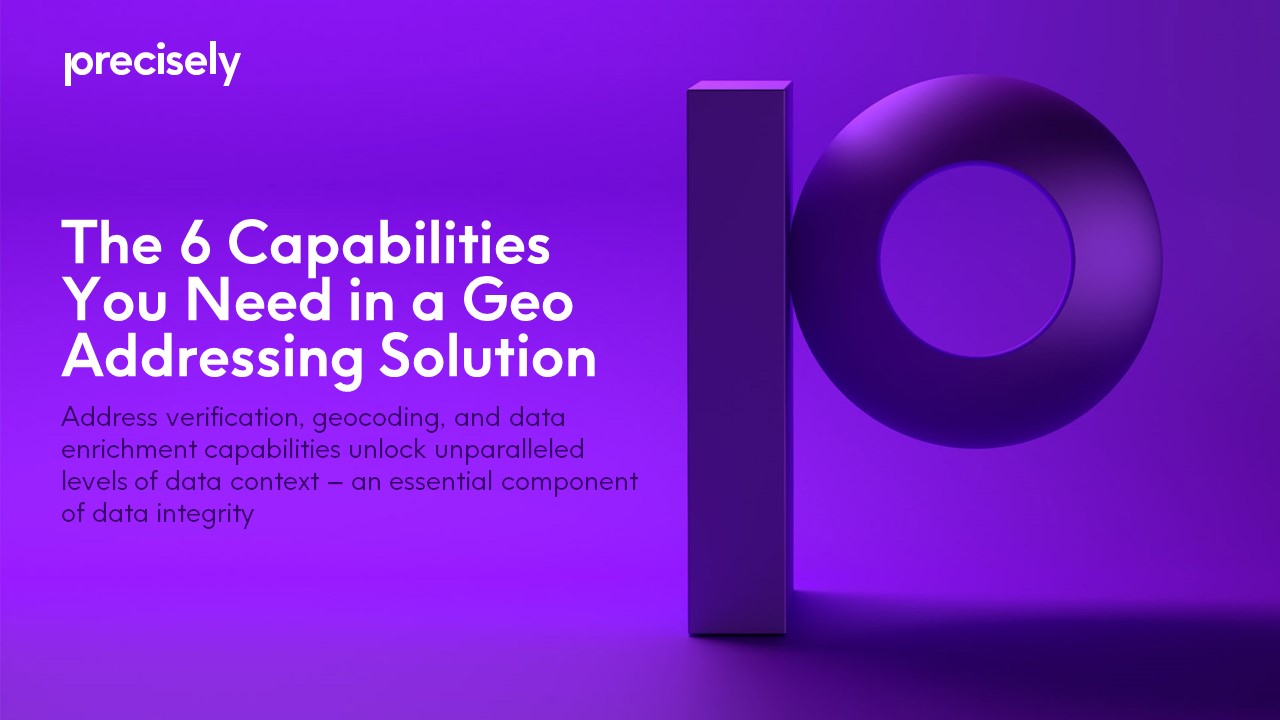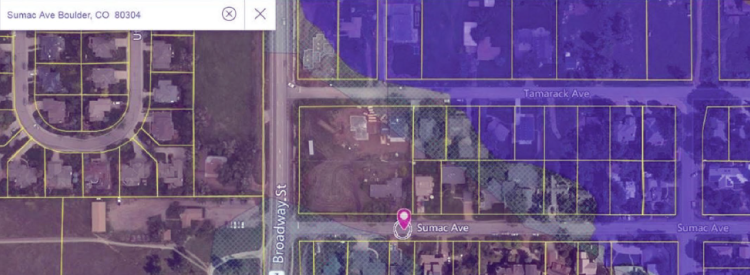eBook
The 6 Capabilities You Need in a Geo Addressing Solution
Address verification, geocoding, and data enrichment capabilities unlock unparalleled levels of data context – an essential component of data integrity
Read this eBook to explore the considerations for selecting a geo addressing solution that supports a winning location intelligence business strategy.
Getting to know geo addressing technology
So what exactly is geo addressing? Let’s first illustrate with an example.
- 346 Main Apt A
- 346-A Main St.
- 346 Main Street Unit A
While each listing has a slight variation, they’re all likely referring to the same address. But, which one is correct?
That’s where you need the essential data integrity element of context. Without it, address data becomes one of the most challenging data types to work with – and considering how frequently used and foundational this information is to many business decisions, that utilization truly needs to be as seamless as possible.
Thankfully, Precisely is here to help. Inputting addresses into operations is not only a core competency for our organization, it’s an area where we’re a global leader. We call it geo addressing technology.


Our geo addressing and data enrichment solutions enable organizations of all sizes to increase the use of address data and quickly associate rich, relevant contextual information.
Geo addressing consolidates the capabilities from our world-class geocoding and address verification solutions into a single solution.
The results? Faster, more confident decision-making.
Geo addressing delivers:
- Sophisticated address matching algorithms for the most accurate address verification across countries, languages, and character sets.
- The most positionally accurate locations (latitude/longitude) – including rooftop and even sub-building
- The PreciselyID – a unique and consistent identifier attached to an address, that simplifies enrichment and powers operations
- Metadata for each address match – delivering trust and powering automated decision-making at scale
- Address Autocomplete – returning a suggested list of complete addresses based on partial address keystrokes – useful for any local search, checkout, shipping, or billing experience on your website.
What does world-class geo addressing look like?
Leveraging location for better decisions
Accurate location provides context to better inform business decisions
Business operations in industries as diverse as insurance, financial services, and telecommunications are more reliant than ever on location intelligence.
Location intelligence is the art and science of analyzing the connections between geospatial locations (latitude and longitude coordinates) and what exists or occurs in these locations (customers, businesses, crimes, weather events, traffic, etc.).
But before you can analyze the connections, you need to define them, associating each location-based record with accurate geospatial coordinates. That’s geocoding.
Local governments are using geocoding-embedded mobile solutions to increase citizen engagement.
Location is at the heart of key business questions:
- How can we sell to more homes within our service area?
- Is the insured property in an area with increased risk of natural or manmade hazards?
- Is our home loan portfolio overexposed in a high-risk market?
What to look for in a geo addressing solution
With so many factors affecting the geo addressing process, rational assessment of address verification and geocoding solutions can be an overwhelming task.
To help you along, we’ve organized geo addressing capabilities into six categories:
1. Matching
The interpretation of an input address and matching it to reference data
2. Address Verification
This process will parse, standardize, verify, cleanse, and format address data
3. Positional Accuracy
How close is the geocode to the specific addressable location you’re targeting?
4. Throughput
How many records per unit of time can be processed? It’s an essential business consideration.
5. Metadata
The data you have about your geocoding results, which enables operational automation and insights
6. Deployment Options
Where will the geo addressing capabilities reside? How will it integrate into existing business processes?
Now that we’ve identified these six geo addressing capabilities, let’s explore each in more detail.
1. Matching
Your business may depend on it
Match rate
This is the proportion of input addresses that the geo addressing solution accurately matches with the correct address in the reference data – streets, boundaries, addresses, etc.
Simply put, a higher match rate gives you more answers. This is essential if you want to embed address verification and geocoding capabilities in heavily used applications, especially those that are business- and mission-critical.
However, you need to beware of solutions with high match rates that end up having a high rate of false positives.
Let’s examine Figure 1: one input, four addresses. Would your solution know which to use?
Geo addressing with more sophisticated matching algorithms teases out the right address, even with incomplete input data. This is essential for automated decision-making applications, or anytime you want to minimize manual error correction and other human interventions.
Coverage
When targeting a single country, look for a geo addressing solution with national address coverage. If your scope of business is international, you’ll also need to specify coverage for all the countries you target.
The best way to ensure the broadest coverage is to use a geocoder that combines the data from the various sources into a single unified offering.
Database update frequency
Keep in mind that the human landscape is highly dynamic. Addresses change, as do territory designations – like postal codes, neighborhoods, and administrative boundaries.
You’ll want to look for quarterly, or even monthly, updates whenever possible.

Figure 1.
2. Address Verification
Avoid costly problematic addresses – especially across multiple countries
Accuracy for peak personalization
Reaching customers with effective, personalized communications is imperative for businesses. Address verification makes it easy.
Verify addresses in real time across more than 250 countries and territories – and automatically recognize data by country, even down to primary house numbers and apartment units. By managing multi-national characters and applying casing to correctly format and validate your data, you can reach your customers in new, tailored ways.
Build confidence with autocomplete
A tailored experience is also important to several of your other business needs. More relevant address suggestions empower confidence in your decisions.
You’ll be able to capture the right address in real time thanks to smart autocomplete features that return a suggested list of complete addresses, based on partial address keystrokes – useful for any local search, checkout, shipping, or billing experience on your website.
3. Positional Accuracy
Make sure the geocodes serve your business needs
Getting to the ground truth
Do your decisions depend on the attributes of specific residences or businesses? If so, geocodes calculated to the ZIP Code, neighborhood, or even street centroid are not accurate enough.
You need flexible positional accuracy – that is, the ability to obtain coordinates that are most appropriate for each use case. Demographic profiling, for example, requires less positional accuracy than insurance underwriting.
In any case, the geocoder should provide metadata specifying the accuracy level attained. Companies that use geocodes in automated decision-making processes need this metadata to minimize the risk of decision errors. Read on for more information on metadata.
Positional accuracy is key to answering a variety of questions:
- Is a house in an area of high fire risk?
- How can we target our advertising to families living in apartments with more than two kids?
- Which downtown businesses can I service with my existing fiber optic infrastructure?

Let’s say a customer applies for property insurance. In this case, the geocoder uses an interpolated property location, placing the geocode just outside a flood zone. If you’re not confident in the positional accuracy of your geocoder, do you quote a flood-zone rate, and risk losing the business? Or do you quote the lower rate and assume the risk if you’re wrong?
4. Throughput
Keep up with high-volume analysis and cloud-native/big data processes
Geo addressing is the foundation of highly automated operational processes where addresses and their locations power the outcome.
Leading solutions can process hundreds of millions of records per hour.
Throughput is also an important factor for geocoding for big data/cloud-native analytics. If your organization operates or is considering deploying your applications using cloud-native or big data, such as EMR or Spark, you’ll want to insist on a geo addressing solution that runs within these environments, minimizing the need for custom software integration.
Case in point:
Property and casualty insurance
In this industry, profitability hinges on the accuracy of risk assessments – and location attributes are key factors here.
Because location attributes change frequently, many insurance companies update geocodes for their whole book of business every month. Only with high throughput is such an effort practical for the business.
5. Metadata
Gain more insight with data-rich geo addressing

Advanced geo addressing is well-equipped to support automated decision-making and in-depth analysis by generating and delivering various metadata. This information may include insights into how well the input address matched the reference data, the type of point returned and its level of positional accuracy.
Another type of metadata is a unique and persistent identifier. Attached to an address, not a location, this identifier can be used to quickly obtain the address in the future, even if the location of the address or the address itself changes. It can also improve operational processes between systems or companies, and even unlock further information from additional data files or APIs.
Metadata about primary-secondary relationships between locations (such as suites within an office building) can save you countless hours of research.
Finally, there’s metadata that consists of links to additional information related to the geocoded location. This metadata can speed up analytical processes by revealing previously unknown relationships between location-related data.
Imagine you’re considering investing in office space in a large building. Geocoding the exact mailing address can tell you about that geographic location and the specific office.
But are there issues with other offices in the building that may impact your business?
Relationship metadata allows you to quickly track down information about locations with the same primary address (apartment units within a complex, for example). Or if you’re interested in the entire building, that single geocode can give you all the metadata for the individual units within the building.

6. Deployment Options
Choose a geo addressing solution that flows with your business
Deployment environment
As your business evolves, so will your IT needs and capabilities. Choose a flexible solution now to save yourself potential headaches and unexpected costs later.
On-premises geo addressing should be easy to embed into server and desktop applications. Cloud-based solutions should offer the same results and rich capabilities as on-premises options.
Integration
Apart from GIS professionals, few business users need geo addressing as their final output. Most users performing spatial analysis need geo addressing built into their business process workflows and applications. The faster you can integrate your solution into existing and new applications, the shorter your time to value.
To make integration easier, look for solutions that interface with multiple web service protocols (such as REST and Java) and support various programming languages and operating modes, such as client/server, batch, and interactive.
Can your geocoder provider say yes to all these deployment options?
- On premises/Private cloud
- Cloud-native/Big data
- Cloud: APIs
- Cloud: SaaS
- Hybrid deployments
- Any operating system
Let’s put a finer point on this.
Please contact us to obtain more in-depth information about selecting geo addressing technologies to support your business objectives.

